This message provides entry filing instructions for Section 232 duties on Medium- and Heavy-Duty Vehicles (MHDVs), Medium- and Heavy-Duty Vehicle Parts (MHDVPs) and buses pursuant to Presidential Proclamation 10984 issued on October 17, 2025.
BACKGROUND
On October 17, 2025, the President issued Proclamation 10984, “Adjusting Imports of Medium- and Heavy-Duty Trucks, Medium- and Heavy-Duty Truck Parts, and Buses into the United States,” under Section 232 of the Trade Expansion Act of 1962, as amended (19 U.S.C. 1862), imposing between 10 to 25 percent ad valorem tariffs on imports of MHDVs and MHDVPs and buses and other vehicles, effective November 1, 2025. See Adjusting Imports of Medium- and Heavy-Duty Vehicles, Medium- and Heavy-Duty Vehicle Parts, and Buses into the United States, 90 FR 48451 (October 22, 2025).
ENTRY FILING INSTRUCTIONS
This guidance provides instructions for importers, brokers, and filers on submitting entries to U.S. Customs and Border Protection (CBP) subject to tariffs on MHDVs and MHDVPs from all countries that are provided for in headings 9903.74.01 through 9903.74.11, respectively. This guidance also provides instructions on submitting entries for tariffs on other parts of passenger vehicles and light trucks from all countries that are provided for in headings 9903.94.07 and 9903.94.33 through 9903.94.55.
The additional duties will take effect with respect to goods entered for consumption, or withdrawn from warehouse for consumption, on or after 12:01 a.m. Eastern Daylight Time on November 1, 2025.
MEDIUM- AND HEAVY-DUTY VEHICLES (MHDVs) AND BUSES
9903.74.01: Applies to imports of MHDVs classifiable in headings 8701, 8704, 8705, 8706, and 8709 of the Harmonized Tariff Schedule of the United States (HTSUS) classifications enumerated in subdivision (b) of U.S. note 38 to subchapter III (see attached list of HTSUS classifications).
25% additional ad valorem rate of duty
9903.74.02: Applies to imports of buses and other vehicles classifiable in heading 8702 of the HTSUS enumerated in subdivision (c) of U.S. note 38 to subchapter III (see attached list of HTSUS classifications).
10% additional ad valorem rate of duty Read More→
https://content.govdelivery.com/bulletins/gd/USDHSCBP-3f93b75?wgt_ref=USDHSCBP_WIDGET_2


